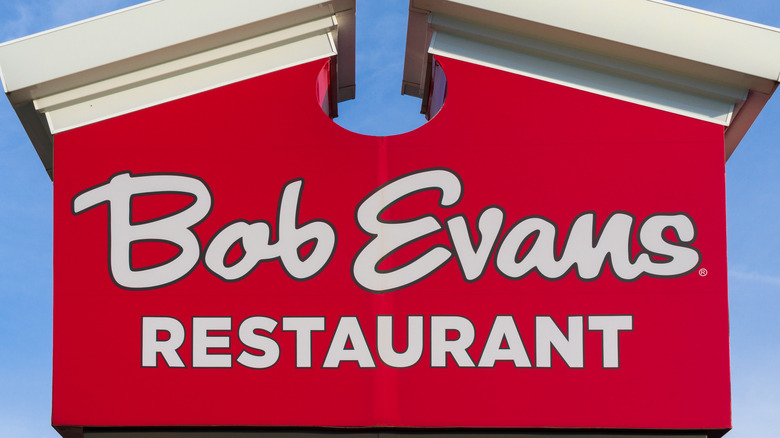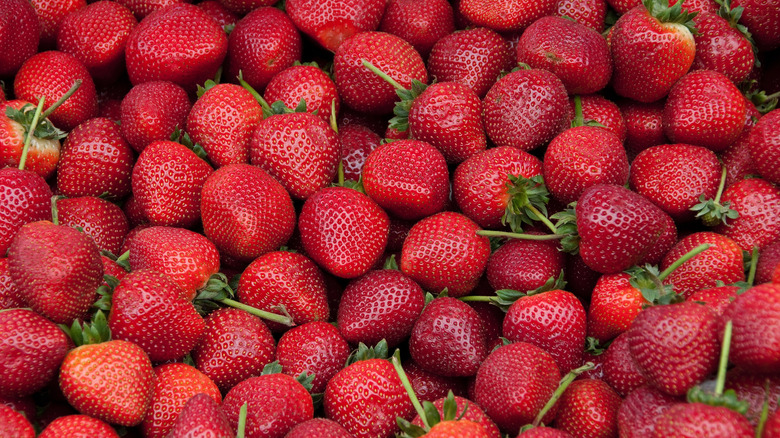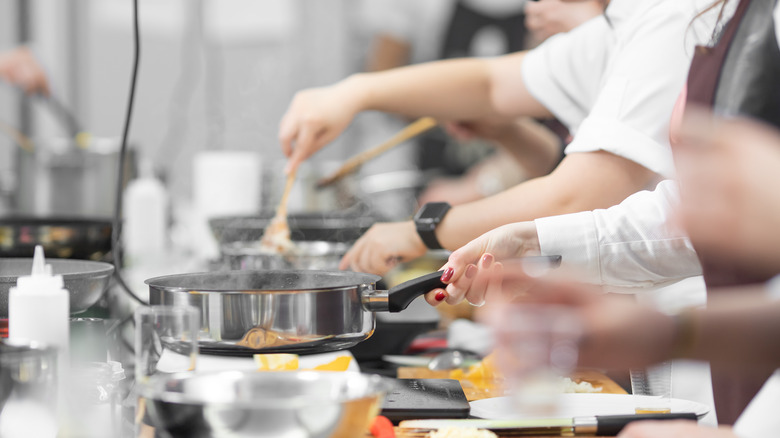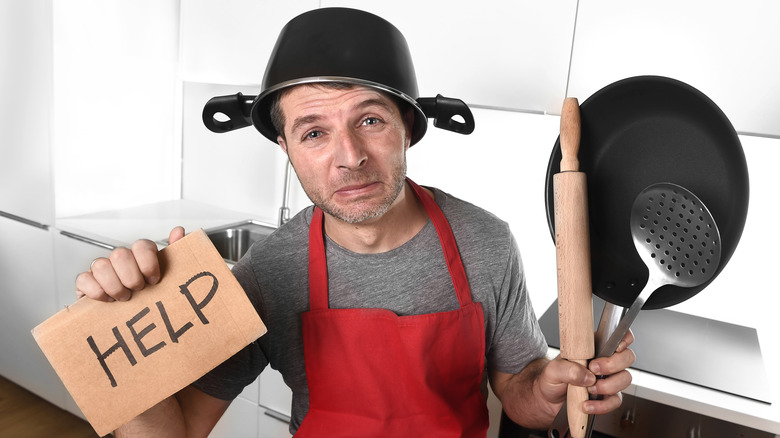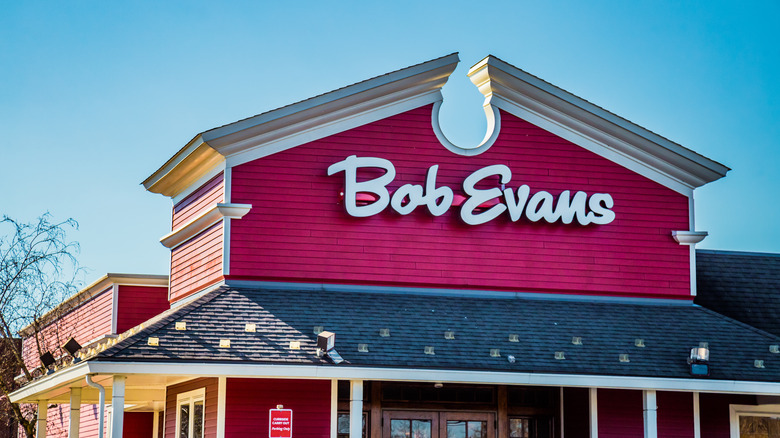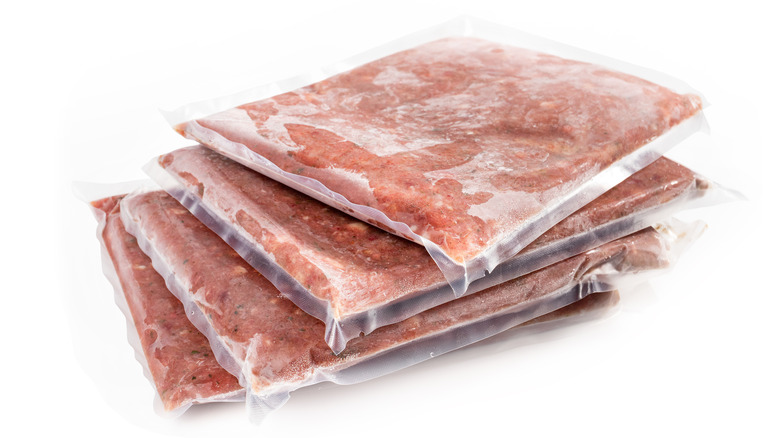We Finally Know Why Bob Evans Is So Cheap
Bob Evans started out in Ohio as a humble country sausage operation that soon grew into a popular full-service diner. A quarter of a century later, Bob Evans has blossomed into a beloved chain of nearly 500 restaurants across 18 states (via Bob Evans). Well-known for its hotcakes and classic breakfast fare, Bob Evans also dishes up hearty menu items like hand-breaded fried chicken, country fried steak, and slow-roasted turkey with dressing and gravy.
For just under ten bucks, you can score an impressive plate of breakfast that includes two fresh eggs with hash browns or home fries, fresh fruit or warm biscuits, and your choice of hardwood-smoked bacon, hickory-smoked ham, or some of Bob Evans' famous country sausage. Or for just a few bucks more, you can enjoy some fork-tender pot roast that also comes with carrots, caramelized onions, mashed potatoes, and homestyle beef gravy with dinner rolls. If you've ever wondered how Bob Evans manages to pull off feeding the masses such filling meals for such reasonable prices, you're not the only one. We plundered the depths to find some answers and now we finally know why Bob Evans is so cheap.
Bob Evans capitalizes on seasonal ingredients
There are multiple benefits to using seasonal ingredients. For one, when you buy produce that's in season you get it at a much better price (via The Spruce Eats). The reason produce is cheaper when it's in season is because that's when the produce is most abundant. Bob Evans makes a habit of wisely using seasonal ingredients to promote new menu items that feature seasonal produce. Case in point: For strawberry season, Bob Evans is offering lots of different dishes that feature the crimson queen of fleshy fruits. French toast with fresh strawberry sauce, vine-ripened strawberries on a stack of hotcakes, strawberry pie, and fresh summer salads are just some of the seasonal dishes that Bob Evans is putting in the spotlight.
Not only is it more cost-effective to use seasonal ingredients, but it's also much tastier. That's because fruits that are grown during their natural season end up being more nourishing and flavorful than if they were grown in artificial weather conditions (via WebMD). Beyond this, eating seasonal ingredients is much better for the environment because it's more sustainable and requires less energy. By capitalizing on seasonal ingredients, Bob Evans is saving money, helping the environment, and also providing its restaurants with better-tasting food.
Some menu items might be pre-made
It's quite common for larger chains to outsource some of their food production. That's because outsourcing has the potential to actually increase productivity and can reduce the overall costs of doing business (via Portland Community College). On the one hand, having some menu items premade off-site is sure to cut down on the time it takes cooks in the kitchen to finish orders, but on the other hand, it also reduces freshness. Striking a balance between the convenience of outsourcing and the quality of fresher ingredients is the key to offering great food and fast service.
According to an alleged former Bob Evans employee on Reddit, the only thing that's made fresh in-house is the brioche bread. While that claim seems a bit overblown, it's still reasonable to assume there some parts of the menu are premade, considering that bigger chain restaurants like Bob Evans are typically focused on getting food on your plate as fast as possible. Using premade food cuts down on labor costs and increases efficiency, which helps keep menu prices cheaper.
Bob Evans has a network of farms around the country
Bob Evans started out as a modest farm that specialized in using local ingredients to create fresh food products that people loved. Several decades later, that same commitment to investing in farm-grown goods is still alive and well, according to the company. Bob Evans has expanded its farm system around the country. By investing in an extensive chain of farms, Bob Evans can strategically deliver freshly-grown products to customers at its restaurants.
There is another important advantage to having an expansive network of farms: it can be more profitable. Since Bob Evans is supplying its own ingredients instead of buying them from an outside source, it's eliminating the middleman between farm and restaurant, potentially reducing the amount of money it spends on ingredients. By investing in farms around the country, Bob Evans has positioned itself to deliver fresh food in a cost-effective way, which may translate into better prices for customers.
It relies on cheap seasonings
Everyone knows that seasoning plays an important role in developing the flavor of a dish. As a major flavor enhancer and a vital substance that our bodies require, salt is the undisputed king of seasonings. In fact, salt is so crucial for so many different processes that during the Civil War, when salt was especially valuable, some leaders even offered a military waiver to anyone who was willing to work in salt production (via History). These days, salt is obviously still highly useful but it's much more abundant and cheaper in price.
Using salt in the kitchen can be a little tricky. Too much of it can overwhelm a dish and render it practically inedible. Not using enough can leave a dish dreadfully bland and boring. According to a study by Technomic, chain restaurants tend to rely on salt to make dishes flavorful since it's cheap and abundant. Looking at the nutrition guide for some of the menu items at Bob Evans shows that a few dishes are exceptionally high in sodium (via Bob Evans Nutrition Guide). The slow-roasted turkey, honey butter chicken biscuits, and chicken-n-noodles deep-dish dinners all have over 2,300 milligrams of sodium, which is above the FDA-recommended sodium intake for an entire day's worth of meals. Using a heavy hand with the salt is a cheap way for Bob Evans to enhance flavor that keeps food costs down, which creates cheaper prices.
Bob Evans pays some employees low wages
A restaurant's success largely depends upon the cooks in the kitchen. After all, without the hard work of cooks, restaurants wouldn't be able to serve up any of the food on the menu and the business would be doomed to fail. Despite this, many restaurants in the industry pay cooks fairly low hourly wages, even though the work is skilled and physically demanding.
According to the US Bureau of Labor Statistics, the mean hourly wage for cooks across America clocks in at about $15 an hour. This is above what the average cook makes at Bob Evans, which is about $12 an hour (via Payscale). That three dollar difference may not seem like much, but it adds up over time. By paying some of its cooks low wages, Bob Evans is maximizing its profits and minimizing its expenses, which helps the company keep prices low on its menu.
Breaks can be few and far between
Anyone who's worked in the restaurant industry knows that regularly scheduled breaks can be hard to come by. In a fast-paced environment that can often be unpredictable, management tends to prioritize serving the customers in the dining room rather than making sure its labor force gets some much-needed downtime to briefly recharge. As you'd imagine, not having opportunities for consistent breaks can be distressing and draining for workers.
According to an anonymous alleged former employee of Bob Evans on Glassdoor, the company has a hard time making sure workers get their breaks. The alleged former employee claims that there was a lot of inconsistency and that there were some seven-hour shifts where they didn't receive a single break. In the advice to management section of the review, the alleged employee urges managers to prioritize breaks for all employees. While not ideal for the workers, this approach can increase the speed with which customers are served and boost revenue, which is good for business and keeps prices affordable.
Hierarchical employee discounts
Employee discounts are a nice way to sweeten the pot for workers. Discounts can be an effective way of expressing some gratitude and making workers feel a little more appreciated for devoting so much of their time and energy into boosting a company's bottom line. And let's face it, when you're working in a restaurant surrounded by so much food, it seems more than fair to let employees enjoy a cheaper meal, considering they're the ones working so hard to make sure everyone else is fed.
So it's great that all of the workers at Bob Evans are entitled to a discount. But apparently, the way those discounts work is a bit complicated. While all of the management staff can eat meals totally for free, all of the other employees get a certain percentage of their meals off that depends on when the meal is eaten. If the employee is at work, they get 50% of the meal off. But if they happen to come in on a day off to eat, the discount drops down to only 20%. Being frugal with employee discounts allows the company to maximize its profits, which helps the restaurant save money and offer menu items at cheaper prices.
All locations are company owned
It's quite common in the restaurant industry for some locations to be franchised. For those unaware, a franchise is basically when someone is given some management control over a business model that they don't entirely own and get rewarded with a slice of the profits (via Eater). Some popular chain restaurants that allow franchises are Taco Bell, Subway, McDonald's, and Chick-fil-A. Bob Evans, on the other hand, doesn't allow franchises at any of its locations.
Part of the reason Bob Evans doesn't allow franchises is so that the company can be in more control of its business and properties. There are some advantages to this including a more simplified closing process and the ability to sidestep rent hikes. The franchise business model can come with a complicated set of operational rules as well. The bottom line is that avoiding franchises gives Bob Evans more freedom to conduct business the way it wants to. By creating a business model that ensures all locations are company-owned, Bob Evans is saving itself some potential headaches down the line and also potentially saving money on its properties, which translates into better prices for customers.
The meat might be frozen
Restaurants tend to take pride in boasting about how their food is fresh and made from scratch. The moment we know a restaurant makes something from scratch — maybe some freshly baked biscuits or burger patties that are house-blended — we always feel a jolt of hope and anticipation. That's because meals cooked with fresh ingredients tend to taste better than premade frozen stuff. Beyond this, frozen food might still taste good but it's often unhealthy, less nutritious, loaded with preservatives, and higher in sodium (via The Washington Post). That said, it also really saves restaurants a lot of time.
So it should come as no surprise that many successful chain restaurants use frozen food to speed up preparation time and save on labor costs in the kitchen. According to an alleged former Bob Evans employee on Reddit, the meat at its restaurants comes in frozen. Beyond cutting down on some prep time in the kitchen, freezing has other benefits, such as drastically extending its shelf life, which reduces waste and keeps food costs down (via USDA). While freezing food might reduce its quality to varying degrees, it's still a very cost-effective way to stay stocked up. If the alleged former employee's claim is true, then Bob Evans is scaling down food waste and prolonging the shelf life of its products by using frozen meats. And that turns into cheaper prices on the menu that are easier on the wallets of its customers.
